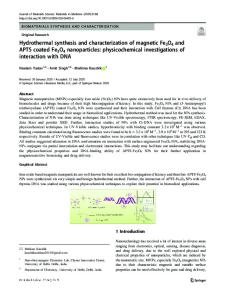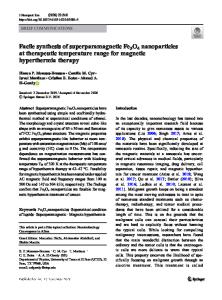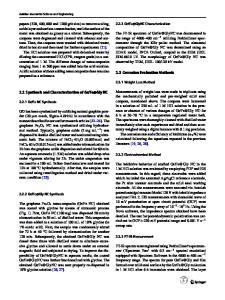Sonochemical synthesis of magnetic Fe 3 O 4 /graphene nanocomposites for label-free electrochemical biosensors
- PDF / 4,744,907 Bytes
- 13 Pages / 595.276 x 790.866 pts Page_size
- 9 Downloads / 347 Views
Sonochemical synthesis of magnetic Fe3O4/graphene nanocomposites for label‑free electrochemical biosensors Rhesti Nurlina Suhanto1 · Suksmandhira Harimurti2 · Ni Luh Wulan Septiani1 · Listya Utari1 · Isa Anshori2 · Hutomo Suryo Wasisto3 · Hiroaki Suzuki4 · Suyatman1 · Brian Yuliarto1,5 Received: 21 March 2020 / Accepted: 25 July 2020 © Springer Science+Business Media, LLC, part of Springer Nature 2020
Abstract This work reports on sonochemical synthesis of carbon paste electrodes modified with magnetic Fe3O4/graphene nanocomposites as a label-free electrochemical biosensor for prostate-specific antigen detection. To optimize their properties as a biosensor, the compositions of both F e3O4 and graphene were varied. The as-synthesized nanocomposites possess good crystallinity and purity with Fe3O4 nanoparticles attached onto the graphene surface. From voltammetry measurements, the modified electrode shows an increase of reduction peaks as compared to the bare electrode which promisingly led to a more sensitive biosensing detection. The modified electrode was then used for biomarker detection through the immobilization of the anti-prostate-specific antigen (anti-PSA) antibodies onto it. The results showed that the electrochemical signal increased linearly against PSA concentration, from 1 to 150 ng/mL, with a detection limit of 0.38 ng/mL. Having all these characteristics, the F e3O4/graphene nanocomposites offer a promising path towards the development of highly sensitive prostate biosensors, especially for cancer detection.
1 Introduction Biomarkers are biological molecules that are typically found in body fluids (e.g., blood, urine, or cerebrospinal fluid), cells, and tissues. They can be an indicator of abnormalities in physiological processes and are used for diagnosis of specific illness and therapeutic drug monitoring [1]. In the case * Brian Yuliarto [email protected] 1
Advanced Functional Materials (AFM) Laboratory, Department of Engineering Physics, Institut Teknologi Bandung, Jl. Ganesha 10, Bandung 40132, Indonesia
2
Lab‑On‑a‑Chip Laboratory, Department of Biomedical Engineering, Institut Teknologi Bandung, Jl. Ganesha 10, Bandung 40132, Indonesia
3
Institute of Semiconductor Technology (IHT) and Laboratory for Emerging Nanometrology (LENA), Technische Universität Braunschweig, Hans‑Sommer‑Straße 66, 38106 Braunschweig, Germany
4
Graduate School of Pure and Applied Sciences, University of Tsukuba, 1‑1‑1 Tennodai, Tsukuba, Ibaraki 305‑8573, Japan
5
Research Center for Nanoscience and Nanotechnology (RCNN), Institut Teknologi Bandung, Jl. Ganesha 10, Bandung 40132, Indonesia
of early disease detection, rapid monitoring of such biomarkers is very critical, especially for the deadly diseases (e.g., cancer, autoimmune, and heart attack). Therefore, medical diagnostic technology in clinical analysis has moved further towards biosensor technology [2]. Electrochemical biosensors have been developed very actively and used already as an alternative method to detect cancer because
Data Loading...











